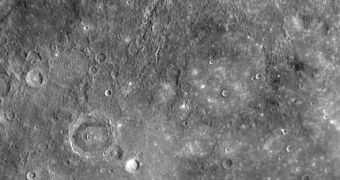For decades, astronomers have held that the solar system's innermost planet, Mercury, was nothing more than a desolate world, completely dead and inhospitable to human life. All that began to change since last October, when the MESSENGER spacecraft started beaming back images of the planet, which it took during its fly-by. According to the photographs, there is a huge degree of volcanic activities on the surface. Numerous weird craters have also been spotted, and astronomers have moreover identified a very strange space formation – magnetic tornadoes that rip plasma from the Sun and channel it directly into the surface of the small planet.
“It’s definitely not this picture of an ancient world where everything that happened to it happened billions of years ago and nothing happened since then. We’re seeing a very dynamic planet that has a lot going on today,” Washington, DC-based Smithsonian Institution expert Tom Watters said.
“Up until before Messenger’s arrival, we weren’t even sure that volcanism existed on Mercury. Now we’re seeing it’s very widespread across the surface,” Arizona State University astronomer Brett Denevi, who is also the lead author of a study detailing the evolution of Mercury's crust, added. The paper appears in a recent issue of the journal Science, alongside many others dealing with the latest fly-by.
The MESSENGER (MErcury Surface, Space ENvironment, GEochemistry and Ranging) spacecraft flew past the innermost planet on October 6th, and sent back a number of photographs during its flight. By combining the latest readings with data sent back by the Mariner 10 space probe, which surveyed Mercury in the 1970s, astronomers have now obtained a 90 to 95 percent complete map of the tiny planet. These maps seem to show that about 40 percent of the body's surface has been generated by volcanic activity, Wired reports.
Thus far, experts have believed that Mercury's surface formed in very much the same way that the Moon's did. They held that, from an early magma ocean, lighter rocks emerged to the surface and then solidified in a tiny and brittle solid surface. Over time, the heat dissipated, and the celestial body became completely solid. However, our Moon exhibits very little signs of volcanic activity, whereas features created by volcano account for less than half of Mercury's surface.
On the other hand, the magnetic tornadoes that were just recently discovered “act as magnetic channels or open windows that allow solar wind plasma from the sun, very fast and very hot, to come right down those field lines and impacts the surface. People had hypothesized that it was because of day-to-day changes in the solar wind, and how much is able to reach the surface and sputter off neutral atoms. We may have discovered the answer to that longstanding question, why is the atmosphere so variable: Because reconnection, when it occurs, is just so intense,” NASA Goddard Spaceflight Center scientist Jim Slavin concluded.

 14 DAY TRIAL //
14 DAY TRIAL //